
| Photos From Wyoming Tales and Trails This page: Upton continued, the deaths of Tom Waggoner, Jimmy the Butcher, Charlie Minter, George Brock and Hike Minter. |
 |

| Photos From Wyoming Tales and Trails This page: Upton continued, the deaths of Tom Waggoner, Jimmy the Butcher, Charlie Minter, George Brock and Hike Minter. |
 |
|
|
|
About This Site |
|
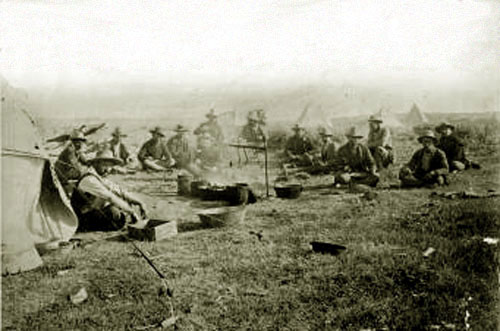 Lunch on Roundup Camp near Upton, approx. 1890. In addition to sheep, the area around Upton was also important for cattle. Both the Standard Cattle Company's 101 headquarted at Moorcroft and The YT Cattle Co., headquartered at Skull Creek about 14 miles east of Upton had operations in the area. The Y T was originally owed by Cheyenne cattle baron Colin Hunter and Laramie County probate judge Isaac Bergman. Hunter sold out his interest in the Y T about 1890 but continued operations under the T Y brand in the Chugwater valley. In 1890, the position of probate judge was abolished. Bergman went into his office and locked the door. From within the sound of gunshots were heard. The door was broken down to discover that Judge Bergman had shot himself several times. One of the shots passed below his eyes. As a result Judge Bergman was not expected to live. Although he was permanently blinded, he survived. Not withstanding his blindness, he was elected to the Laramie County Commission in 1889. He died the following year.
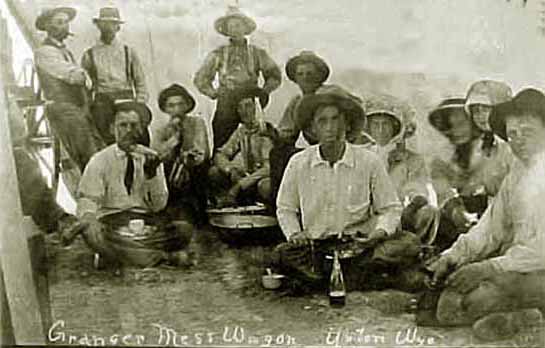 Granger Mess Wagon, approx. 1915. Carlton Lee Granger and his father Henry Granger came to Weston County about 1905 from Nebraska. Each proved up homesteads, Carlton in 1910 and Henry in 1913. Upton was not immune from conflicts involving suspected rustlers and conflicts between cattlemen and sheepmen. In 1890, the Standard Cattle Company sent cattle detective Elias Whitcomb into Merino to solve the rustling problem. Whitcomb later participated in the invasion of Johnson County.
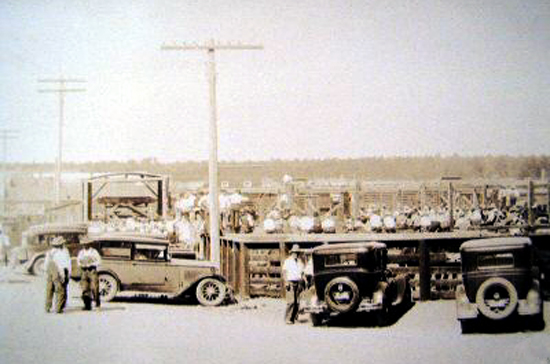 Stock Auction, Upton, approx. 1928. The sheep pens at Upton were burned. "Jimmy the Butcher" who supplied beef to railroad surveyors was arrested for stealing Standard Cattle Co. beeves. Tom Waggoner made the butcher's bond. Jimmy's body was found out in the weeds and was buried next to a house belonging to Joe Eliot. Eliot was a "cattle detective" for the Standard Cattle Co. Waggoner's body was found dangling from a tree. It is generally believed that Eliot had a part in Waggoner's demise.
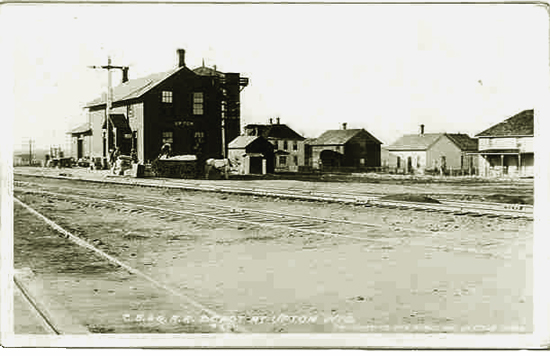 Railroad Depot, Upton, Wyoming. In September, 1905, Charlie Minter and a cowboy named George Brock had words at a sheep dip. Minter had come with his brother from Missouri in 1893, riding penny farthing bicycles from Missouri to South Dakota and then by horse to Merino. They sent for their parents. Brock had possbily come up the Texas Trail to settle in the area. The Texas Trail passed nearby. Minter homesteaded at Beef Draw through which the Texas Trail passed. On September 30, Brock and Minter met up with each other at an establishment owned by George A. Benedict, a major sheepgrower. There Brock pulled a knife on Minter. Minter, in turn, pulled a gun. Bystanders separated the two. Shortly thereafter shots were heard coming from near the railroad depot. Apparently, Minter had spotted Brock who by then was armed with a revolver. Minter fired. Brock returned fire hitting Minter in a major artery. After investigation, the County Attorney declined to prosecute. On August 22, 1910, George Brock and James McCommis had words in which McCommis accused Brock of being a liar. There then ensued a fight in which McCommis hit Brock and Brock, in turn, choked McCommis. As Brock was leaving, McCommis plugged Brock with a 30-30, from the effects of which Brock expired. On Friday night, October 30, 1914, Charley Minter's nephew Hike Minter attended a dance in Upton. Hike was the son of Town Councilman W. H. Minter. Several days later, Hike's brother Ben found Hike dead. Ben believed that his brother had been hanged. The coroner's jury was unable to determine the cause of death. No post mortem was ever conducted. Ben moved to Medicine Bow and never returned to Upton.
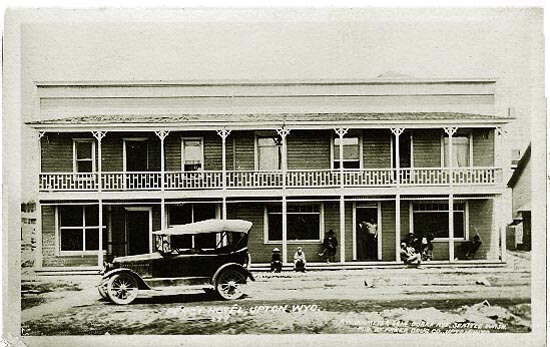 Percy Hotel, Upton, Wyoming, 1920's.
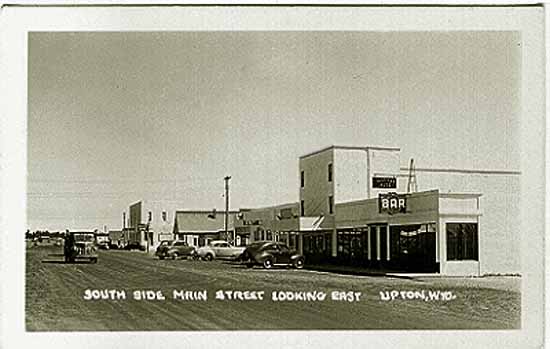 South side of Main Street, U. S. Highway 16, 1941 In the distance on the right-hand side of the street is the two-story Inyan Kara Hotel. Inyan Kara is a small mountain on the western edge of the the Black Hills. The mountain served as a landmark for many of the early exploers of the area, including Gouverneur K. Warren's 1857 Expedition into the Black Hills. The most famous of the expeditions in the vicinity of Inyan Kara was that of George Armstrong Custer in 1874.
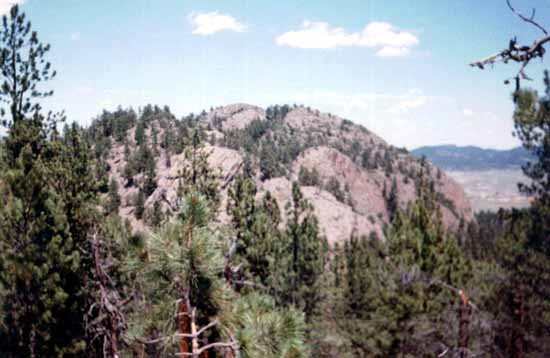 Inyan-Kara On the summit of the mountain carved into the stone are the words, Custer Professor A. B. Donaldson, who accompanied Custer on the 1874 expedition, indicates that Custer, himself, with hammer and chisel, carved his name into the stone. Fron the top of the mountain one may see Sundance Mountain and the Devils Tower. Before climbing the mountain get permission. As previously indicated, Crook and Weston Counties were early the scene of coal and gold mining. Additionally oil was found south of Upton near Osage. However, it was a different form of mining that proved to be of greater importance to the area. Surrounding the Black Hills in a great circle is a band of clay, bentonite, formed by volcanic ash in the shallow seas that seventy-five million years ago overlay the area. Large beds of the bentonite lie along Iron Creek between Upton and Osage 15 miles to the southeast. About two miles northwest of Upton is the railroad siding of Colloid named after the company which opened the first major bentonite mill in Upton.
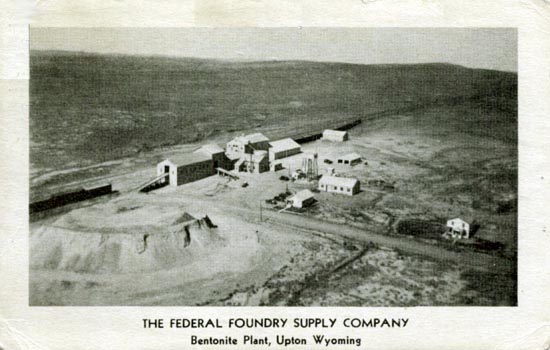 Although, bentonite, named after the ghost town of Benton near Ft. Fred Steele east of Rawlins where it was first discovered, has been mined since the late 19th Century, its major applications for industiral use in steel foundaries and as a lubricant for oil drilling dates to the 1920's. Prior to such use, its primary purpose was in cosmetics as "Denver mud." In 1924, a group of former gold miners in Deadwood formed the the Bentonite Mining & Manufacturing Company. In 1927 a former chicken farmer, Paul Bechtner, formed a partnership with the founders of Bentonite Mining. Bechtner had discovered the value of bentonite in the formation of foundary molds for automobile engines. In 1928, the newly partnership, now called, the American Colloid Company, constructed a bentonite mill at Upton. The same year, the Kansas City Silica Company constructed a plant near Osage. "Colloid" is a trade name derived from the Greek Kolloid meaning "glue-like." In this sense, the term Colloid is aptly named. Bentonite is an extemely sticky clay. When the clay is wet one might be easily trapped. The clay will adhere to one's boots with a incredible tenacity. The clay on the boots will then stick to the floor mats of one's truck, the upholstery, and anything else with which it comes in contact. It has the marvelous ability to expand 15-fold when wet. Its properties have been explored as a cure for diarrhea and as an intestinal detoxificant. Next page: Clay Spur. |